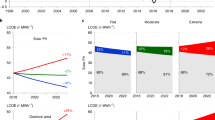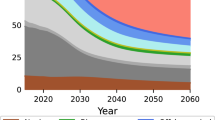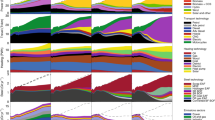Abstract
Learning rates are a central concept in energy system models and integrated assessment models, as they allow researchers to project the future costs of new technologies and to optimize energy system costs. Here we argue that exchange rate fluctuations are an important, but thus far overlooked, determinant of the learning-rate variance observed in the literature. We explore how empirically observed global learning rates depend on where technologies are installed and which currency is used to calculate the learning rate. Using global data of large-scale photovoltaic (≥5 MW) plants, we show that the currency choice can result in learning-rate differences of up to 16 percentage points. We then introduce an adjustment factor to correct for the effect of exchange rate and market focus fluctuations and discuss the implications of our findings for innovation scholars, energy modellers and decision makers.
This is a preview of subscription content, access via your institution
Access options
Access Nature and 54 other Nature Portfolio journals
Get Nature+, our best-value online-access subscription
$29.99 / 30 days
cancel any time
Subscribe to this journal
Receive 12 digital issues and online access to articles
$119.00 per year
only $9.92 per issue
Buy this article
- Purchase on Springer Link
- Instant access to full article PDF
Prices may be subject to local taxes which are calculated during checkout



Similar content being viewed by others
Data availability
The data that support the findings of this study are available from BNEF, but restrictions apply to the availability of these data, which were used under license for the current study and so are not publicly available. Data are, however, available from the authors upon reasonable request and with permission of BNEF.
Code availability
The source code (in R) and supporting documents are available at Zenodo (https://doi.org/10.5281/zenodo.3553796) and can be freely used and manipulated by all users, without restriction, under the MIT licence.
References
Rubin, E., Azevedo, I., Jaramillo, P. & Yeh, S. A review of learning rates for electricity supply technologies. Energy Policy 86, 198–218 (2015).
Samadi, S. The experience curve theory and its application in the field of electricity generation technologies—a literature review. Renew. Sustain. Energy Rev. 82, 2346–2364 (2018).
Wright, T. P. Factors affecting the cost of airplanes. J. Aeronautical Sci. 3, 122–128 (1936).
Gallagher, K., Grübler, A., Kuhl, L., Nemet, G. & Wilson, C. The energy technology innovation system. Annu. Rev. Environ. Resour. 37, 137–162 (2012).
Grübler, A., Nakicenovic, N. & Victor, D. Dynamics of energy technologies and global change. Energy Policy 27, 247–280 (1999).
Ellenbeck, S. & Lilliestam, J. How modelers construct energy costs: discursive elements in energy system and integrated assessment models. Energy Res. Soc. Sci. 47, 69–77 (2019).
Special Report on Global Warming of 1.5 °C (SR15) (Intergovernmental Panel on Climate Change, 2018).
Special Report on Renewable Energy Sources and Climate Change Mitigation (Cambridge Univ. Press, 2011).
Fraunhofer ISE. Photovoltaics Report, Update 10 August 2018 (Fraunhofer ISE, 2018).
Lilliestam, J., Labordena, M., Patt, A. & Pfenninger, S. Empirically observed learning rates for concentrating solar power and their responses to regime change. Nat. Energy 2, 17094 (2017).
Hayashi, D., Huenteler, J. & Lewis, J. Gone with the wind: a learning curve analysis of China’s wind power industry. Energy Policy 120, 38–51 (2018).
Lindman, Å. & Söderholm, P. Wind power learning rates: a conceptual review and meta-analysis. Energy Econ. 34, 754–761 (2012).
Schmidt, O., Hawkes, A., Gambhir, A. & Staffell, I. The future cost of electrical energy storage based on experience rates. Nat. Energy 2, 17110 (2017).
Weiss, M., Zerfass, A. & Helmers, E. Fully electric and plug-in hybrid cars—an analysis of learning rates, user costs, and costs for mitigating CO2 and air pollutant emissions. J. Clean. Prod. 212, 1478–1489 (2019).
Söderholm, P. & Sundqvist, T. Empirical challenges in the use of learning curves for assessing the economic prospects of renewable energy technologies. Renew. Energy 32, 2559–2578 (2007).
Klaasen, G., Miketa, A., Larsen, K. & Sundqvist, T. The impact of R&D on innovation for wind energy in Denmark, Germany and the United Kingdom. Ecol. Econ. 54, 227–240 (2005).
Jamasb, T. Technical change theory and learning curves: patterns of progress in electricity generation technologies. Energy J. 28, 51–71 (2007).
Kittner, N., Lill, F. & Kammen, D. Energy storage deployment and innovation for the clean energy transition. Nat. Energy 2, 17125 (2017).
Huenteler, J., Niebuhr, C. & Schmidt, T. The effect of local and global learning on the cost of renewable energy in developing countries. J. Clean. Prod. 128, 6–21 (2016).
Steffen, B., Matsuo, T., Steinemann, D. & Schmidt, T. Opening new markets for clean energy: the role of project developers in the global diffusion of renewable energy technologies. Bus. Polit. 20, 553–587 (2018).
Egli, F., Steffen, B. & Schmidt, T. A dynamic analysis of financing conditions for renewable energy technologies. Nat. Energy 3, 1084–1092 (2018).
Steffen, B., Hirschier, D. & Schmidt, T. Historical and projected improvements in net energy performance of power generation technologies. Energy Environ. Sci. 11, 3254–3530 (2018).
van Buskirk, R., Kantner, C., Gerke, B. & Chu, S. A retrospective investigation of energy efficiency standards: policies may have accelerated long term declines in appliance costs. Environ. Res. Lett. 9, 114010 (2014).
Wei, M., Smith, S. & Sohn, M. Non-constant learning rates in retrospective experience curve analyses and their correlation to deployment programs. Energy Policy 107, 356–369 (2017).
Gang, C. China’s solar PV manufacturing and subsidies from the perspective of state capitalism. Copen. J. Asian Stud. 33, 90–106 (2015).
Creutzig, F. et al. The underestimated potential of solar energy to mitigate climate change. Nat. Energy 2, 17140 (2017).
van Sark, W., Alsema, E., Junginger, M., de Moor, H. & Schaeffer, G. J. Accuracy of progress ratios determined from experience curves: the case of crystalline silicon photovoltaic module technology development. Prog. Photovoltaics 16, 441–453 (2008).
Nordhaus, W. The perils of the learning model for modeling endogenous technological change. Energy J. 35, 1–13 (2014).
Pindyck, R. The use and misuse of models for climate policy. Rev. Environ. Econ. Policy 11, 100–114 (2017).
van Sark, W. Introducing errors in progress ratios determined from experience curves. Technol. Forecast. Soc. Change 75, 405–415 (2008).
Gan, P. Y. & Li, Z. Quantitative study on long term global solar photovoltaic market. Renew. Sustain. Energy Rev. 46, 88–99 (2015).
Yu, C., van Sark, W. & Alsema, E. Unraveling the photovoltaic technology learning curve by incorporation of input price changes and scale effects. Renew. Sustain. Energy Rev. 15, 324–337 (2011).
Nemet, G. Interrim monitoring of cost dynamics for publicly supported energy technologies. Energy Policy 37, 825–835 (2009).
Renewable Power Generation Costs in 2017 (International Renewable Energy Agency, 2018).
Mauleón, I. & Hamoudi, H. Photovoltaic and wind cost decrease estimation: implications for investment analysis. Energy 137, 1054–1065 (2017).
Junginger, M., Faaij, A. & Turkenburg, W. Global experience curves for wind farms. Energy Policy 33, 133–150 (2005).
Fraunhofer ISE. Current and Future Cost of Photovoltaics (Agora Energiewende, 2015).
Zou, H. et al. China’s future energy mix and emissions reduction potential: a scenario analysis incorporating technological learning curves. J. Clean. Prod. 112, 1475–1485 (2016).
Lin, B. & He, J. Learning curves for harnessing biomass power—what could explain the reduction of its cost during the expansion in China? Renew. Energy 99, 280–288 (2016).
Hong, S., Chung, Y. & Woo, C. Scenario analysis for estimating the learning rate of photovoltaic power generation based on learning curve theory in South Korea. Energy 79 (2015).
Drud Hansen, J., Jensen, C. & Strøjer Madsen, E. The establishment of the Danish windmill industry—was it worthwhile? Rev. World Econ. 139, 324–347 (2003).
Renewable Capacity Statistics 2018 (International Renewable Energy Agency, 2018).
Monthly Average Rates (OFX, 2019); https://www.ofx.com/en-au/forex-news/historical-exchange-rates/monthly-average-rates/
Monthly Monetary and Financial Statistics: Exchange Rates (USD Monthly Averages) (OECD.Stat, 2018); https://stats.oecd.org/index.aspx?queryid=169#
Currencies (Reuters, 2019); https://uk.reuters.com/business/currencies
Schnabl, G. China’s overinvestment and international trade conflicts. China World Econ. 27, 37–62 (2019).
Junginger, M., van Sark, W. & Faaij, A. Technological learning in the energy sector: lessons for policy, industry and science (Edward Elgar, 2010).
Fu, R., Feldman, D., Margolis, R., Woodhouse, M. & Ardani, K. US Solar Photovoltaic System Cost Benchmark: Q1 2017 (National Renewable Energy Laboratory, 2017).
Marston, R. Pricing to market in Japanese manufacturing. J. Int. Econ. 29, 217–236 (1990).
Bloomberg New Energy Finance Database: Renewable Energy Projects (Bloomberg New Energy Finance, accessed 1 September 2017).
Monthly Monetary and Financial Statistics: Relative Consumer Price Indices (OECD.Stat, 2019); https://stats.oecd.org/index.aspx?queryid=168
Acknowledgements
J.L., L.O. and M.M. received funding from the European Research Council (ERC) under the European Union’s Horizon 2020 research and innovation programme (grant agreement no. 715132). We thank F. Egli and M. Meyer for helpful comments on earlier drafts of the paper.
Author information
Authors and Affiliations
Contributions
J.L. designed the study with the support of all the authors and drafted the article, M.M. carried out the quantitative analyses and produced the figures, B.S. designed the correction factor and all the authors contributed to the analysis and the final article.
Corresponding author
Ethics declarations
Competing interests
The authors declare no competing interests.
Additional information
Publisher’s note Springer Nature remains neutral with regard to jurisdictional claims in published maps and institutional affiliations.
Supplementary information
Supplementary Information
Supplementary Notes 1–3, Tables 1 and 2 and Figs. 1–3.
Rights and permissions
About this article
Cite this article
Lilliestam, J., Melliger, M., Ollier, L. et al. Understanding and accounting for the effect of exchange rate fluctuations on global learning rates. Nat Energy 5, 71–78 (2020). https://doi.org/10.1038/s41560-019-0531-y
Received:
Accepted:
Published:
Issue Date:
DOI: https://doi.org/10.1038/s41560-019-0531-y
This article is cited by
-
Assessing long- and short-run dynamic interplay among balance of trade, aggregate economic output, real exchange rate, and CO2 emissions in Pakistan
Environment, Development and Sustainability (2022)
-
Cost Dynamics of Clean Energy Technologies
Schmalenbach Journal of Business Research (2021)
-
Careful currency conversion
Nature Energy (2020)



